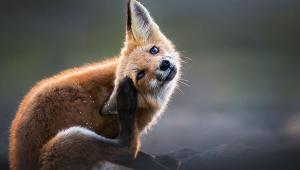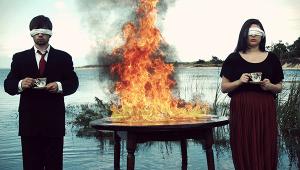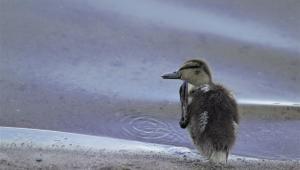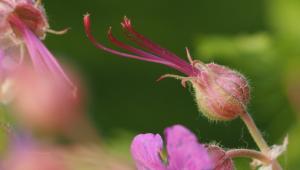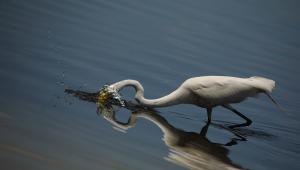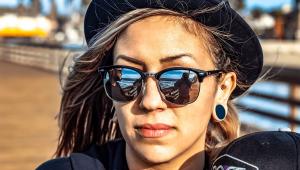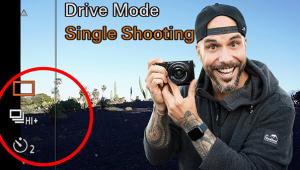Lighting Out: How Travel Photographer Jim Harmer Captures His Illuminating Images

“Our guide in China arranged for us to photograph this gentleman in his home. This posed shot was taken to show how he would typically prepare his lunch.” Jim Harmer used an off-camera flash pointed up at the ceiling as fill, with the window as the key light source. Technical info: Nikon D750, 15-30mm f/2.8 at 21mm; ISO 4000, f/2.8, 1/20 second.
All Photos © Jim Harmer
Jim Harmer didn’t start out as a travel and nature photographer. He was in law school when the photography bug bit him, and, before he knew it, he was traveling the world, capturing moments in time with his camera.
However, it wasn’t enough for Harmer to simply experience the world alone. “I wanted my photography to be a shared experience, with workshops revolving around these adventures,” Harmer noted. “I launched a website (improvephotography.com) as the hub of activity for these workshops. And to make it even more enticing, I made the workshops free. Participants pay their own travel expenses and nothing more, shooting locations around the globe.” All the images Harmer shoots and posts are dedicated toward helping others improve their photographic technique, with an emphasis on seeing the light.
Harmer launched his photographic career in 2010, with a Canon Rebel, eventually moving on to a Nikon D810. But to be more mobile, he made the switch again, this time to mirrorless, specifically the Fuji X-T1 (soon to be upgraded to the X-Pro2).
And, yes, he did graduate law school and pass the bar. “So now I’m a photographer with a really solid backup plan.”

“Iceland is the only place where you can capture the northern lights together with a rising moon, a shooting star, the stars, a mountain (Kirkjufell), a lake, a river, and an icy waterfall all in the same shot.” Shot around 11:30 at night. Technical info: Nikon D810, 16-35mm f/4 at 16mm; ISO 2500, f/4, 30 seconds.
Defining Moment
Shutterbug: What draws you to a scene or subject?
Jim Harmer: It’s got to be the lighting. With landscapes, I’m really obsessive about the lighting. All of my landscapes are shot very early or very late in the day, unless the day is overcast, at which point I’ll shoot during the day as well. But it really depends on where you are. Light doesn’t work the same around the globe and you have to adapt to the lighting in each location.
SB: What constitutes a defining moment that dictates when you release the shutter?
JH: When you’re shooting people, it tends to be a facial expression or bodily attitude. If it’s a landscape, it’s when you get a little bit of action hitting the scene. For instance, a wave breaking on the shore or the light just as it pours out of a lighthouse or a bus passing by. Just a little bit of action can sometimes make a big difference in a landscape. And other times there isn’t any specific moment when you’ve got to release the shutter.
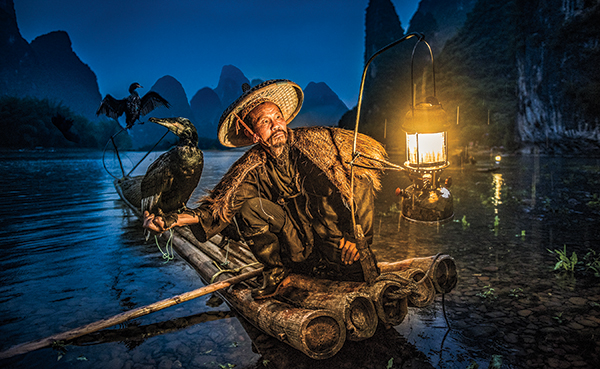
This is one of a handful of traditional cormorant fishermen still in this region. The guide arranged the shot, but when Harmer tried to get the fisherman to pose a certain way, the fisherman overruled him and did his own thing. The lighting was entirely ambient. Technical info: Nikon D750, 24-70mm f/2.8 at 24mm; ISO 1250, f/2.8, 1/80 second.
Capturing People On Location
SB: Do you approach people the same as landscapes when it comes to lighting?
JH: I approach portraits differently. When I shoot a portrait, I almost always add flash because I feel it’s needed to bring out a person’s features or emphasize a mood or the colors and textures in their clothing.
SB: How do you develop rapport with total strangers in your travels?
JH: I don’t shoot people while skulking in the background. I like to let the person know that I’m photographing them. Usually I don’t speak the language. As a workaround, I find that if I walk up to the person with an enthusiastic expression and motion that I want to take a picture, people will respond in kind. If I walk up to someone and look timid, they’re turned off by the whole idea, or at best, they’ll agree but will return a timid, blank stare instead of the emotional response I’m after.
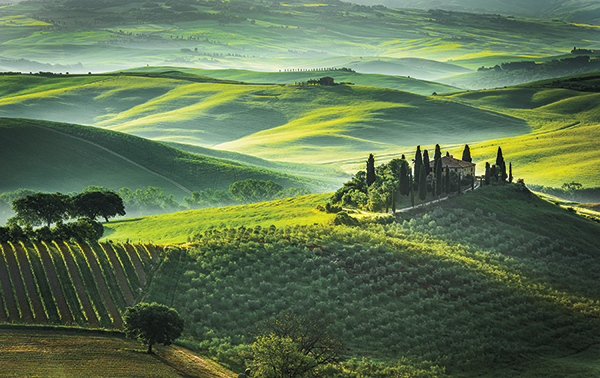
This was shot in the early morning, with the sun just topping the horizon. “I tried shooting this at night, but it didn’t work without the contrast of highlights and shadows.” Technical info: Nikon D750, 70-200mm f/2.8 at 130mm; ISO 100, f/10, 1/100 second.
The Challenges Of Travel Photography
SB: Have you ever faced any intimidating situations shooting travel?
JH: It seems that every time I light things, it attracts the cops. Light painting in cities always brings the cops wondering why someone is standing in the street waving a flashlight around. In Italy, I was on top of a mountain, and my wife went way down into the city, down to this winding road about a mile away. She was walking up and down that street with a flashlight light painting. And that attracted some unwanted police attention.
SB: Do you ever worry about gear being stolen from your hotel?
JH: I lived in Brazil for two years, which isn’t always the safest place. That alleviated the fear factor most people experience in unfamiliar locations. What’s more, I’m used to new countries now, and I’m fairly aware of the risks. Besides, I’m almost always traveling in a large workshop group, so that adds to the safety factor.
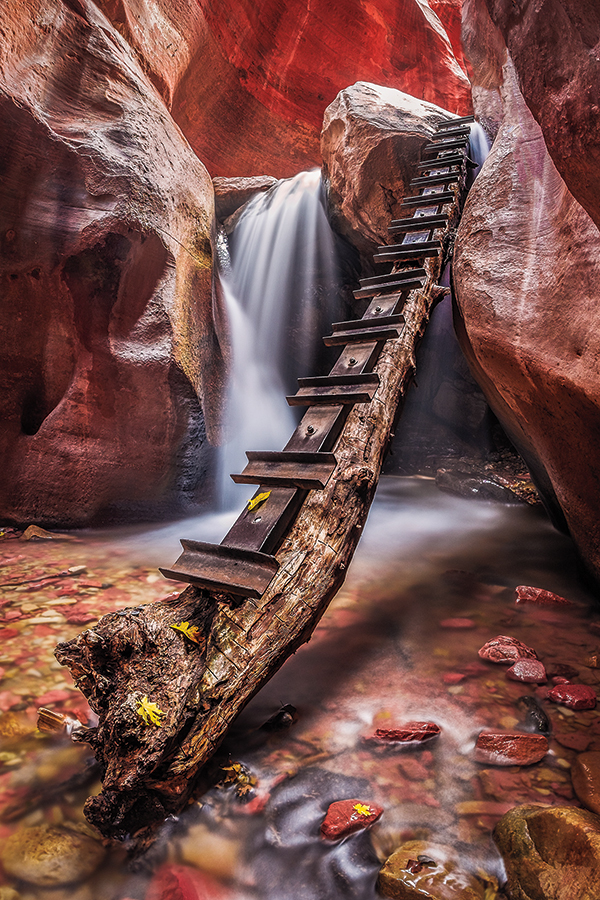
This is a popular location among photographers, but Harmer’s use of forced perspective enhances the image and makes it stand out. “I wore waders while kneeling down in this freezing, ankle-deep water.” Technical info: Fuji X-T1, 10-24mm f/4 at 10mm (= 15mm, 35mm equivalent); ISO 200, f/10, 56 seconds; polarizer.
Getting Technical
SB: How do you employ flash?
JH: When I’m traveling, even for street photography, I’ll attach my flash to a Sirui monopod and walk around holding the monopod with one hand, the camera with the other. This way I get some modeling in the face.
The flash, by the way, is manual. It’s very rare that I use TTL flash. Also, the flash is inside a very small, inexpensive softbox.

This is a composite consisting of numerous elements, among them the foreground wave, the splash, each outcropping, and sky. Most of the elements were shot at sunset, although the sky was actually a sunrise. Harmer used different viewpoints, one even 200 miles away, to capture each element. “When I composite an image, I photograph different things that I like and put it together to represent the experience I was after, while not trying to recreate any specific location.” Technical info: Nikon D800, 24-70mm f/2.8; varying exposures.
SB: Why do you shoot manual flash?
JH: TTL flash is too easily fooled by subject tonalities. If I ask someone to remove a jacket, and that suddenly reveals a white shirt, the flash exposure changes. And I don’t want that. With manual flash I don’t have to deal with such vagaries. For me, manual flash is easier and faster.
SB: How much of your work involves shooting on a tripod?
JH: Everything except portraits.

The scene was captured in the evening, just after sunset. The boat, which was originally 200 yards to the left, was composited into the shot. Owing to a lack of transportation, Harmer ended up trekking for hours back to the hotel. Technical info: Canon EOS 6D, 16-35mm lens; ISO 2500, f/7.1, 30 seconds.
SB: Do you ever shoot tethered to a laptop?
JH: Yes. In the field, when I’m shooting landscapes. It just drives me nuts when I go out and shoot all morning and come back to my computer at the hotel, only to find that one little thing that is wrong, something I couldn’t see on that tiny screen on the camera. Especially at night, when I have the entire evening to shoot a scene, I’ll bring the laptop and shoot tethered.
SB: How do you determine color balance on location?
JH: I always shoot in AWB, then adjust white balance in the Raw file during processing. In Lightroom, I may key WB to a neutral gray tone—a sidewalk, for example. However, my most common method is that I take the WB slider and move it to one extreme or the other, then pull it back until I reach a color balance that feels right to me. That forces me to look at the shot more critically than simply relying on AWB.
I should point out that initially choosing AWB means I don’t have to focus on white balance while I’m shooting. I prefer to just take the picture, be in the moment, and not be distracted by settings as much as possible.
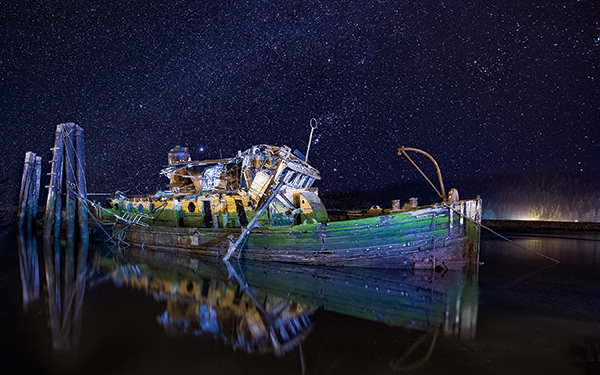
“One of the workshop participants drove by this boat earlier in the day, so we returned at night to shoot it. You have to shoot this at the right time of day. Twenty minutes later, the ebbing tide left only mud in the foreground, which would have been a totally different and lackluster shot.” Harmer and his group light-painted the boat, with one person even climbing aboard with a flashlight. The Milky Way was composited into the main shot, which was captured at midnight. Technical info/boat: Canon EOS 6D, 16-35mm lens; ISO 2500, f/7.1, 30 seconds. Technical info/stars: Nikon D750, Tamron 15-30mm; ISO 3200, f/2.8, 15 seconds.
His Favorite Gear
“The humble YongNuo YN560-IV manual flash (http://en.yongnuo.com.cn/) is by far my favorite piece of camera gear,” Harmer says. “This inexpensive flash boasts built-in wireless capability, and I like how easy it is to operate, and how durable and reliable it is. These manual flashes are well-suited to all my needs.”
What’s in Harmer’s Gear Bag
* Fuji X-T1/X-Pro2 (when it becomes available)
* Fuji 10-24mm f/4 lens
* Fuji 16-55mm f/2.8 lens (for environmental portraits)
* Fuji 50-140mm f/2.8 lens (for tight portraits)
* MindShift Gear rotation180˚ Horizon photo backpack
* Feisol CT-3442 tripod
* Really Right Stuff BH-40 ball head
* Sirui monopod (for the flash)
* YongNuo YN560-IV flashes and YN560-TX transmitter
* 10x and 3x ND filters (for long exposures, usually involving water), polarizer
* Flashlight
Jim Harmer operates out of the Boise, Idaho, area. To see more of his work, visit photographyidaho.com. His website improvephotography.com focuses on becoming a better photographer. For information on his workshops, go to improvephotography.com/workshops.
- Log in or register to post comments











